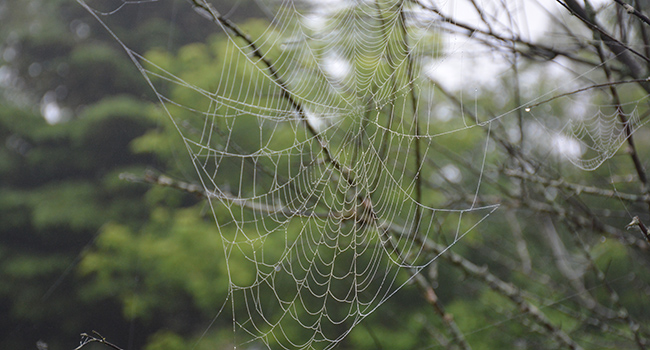
There’s a fascinating Ojibwa legend about how spiders came to build webs. Known as Manitoosh, spiders were starving as flies were difficult to catch. Eventually, Kitche Manitou, the Great Spirit, told the spider to use what they had (webs) but to use it better
 “The itsy-bitsy spider climbed up the water spout. …”
“The itsy-bitsy spider climbed up the water spout. …”
So many people are afraid of spiders, but I’ll bet almost none of them can tell you why.
According to a new study out of Columbia University, it may be genetic.
Our ancestors had to fear spiders – in Africa, where our roots all take us, venomous spiders were common. Recognizing and reacting to them was critical to survival.
Studies show we still see spiders, even when camouflaged, better than most other critters.
I’m not afraid of spiders but I’m always wary. I know we have few venomous species in Ontario, where I live, but I also know that others can bite and it can hurt. So I err on the side of caution.
Here are some reasons you might learn to love spiders:
It’s estimated spiders eat 200 kg of insects per hectare per year. So if you work it out for the geographic area covered by the City of Toronto, that’s the equivalent of about 150,000 average-sized people per year!
Spiders quite happily eat mosquitoes – I wish they would pick up the pace a bit. Spiders also feed on garden pests voraciously. Without them our gardens would be overrun by insects such as aphids.
Worldwide, there are between 40,000 and 100,000 species of spiders. It’s suspected that over half of all the species in the world have yet to be discovered.
Spiders are everywhere, including in our homes. A friend of mine kills every spider she sees in her house. I tell her simply that the spider is a predator and if it’s alive, it must be eating something.

Spiders quite happily eat mosquitoes and they also feed on garden pests voraciously
So unless you want to be overrun by unseen bugs, it’s always better to let a spider live.
There’s a fascinating Ojibwa legend about spiders and how they came to build webs to catch prey. Known as Manitoosh, the spiders were starving as their main food (flies) were difficult to catch and the spider was very clumsy.
Eventually, Kitche Manitou, the Great Spirit, told the spider to use what they had but to use it better. Not understanding, Manitoosh sought council from Nanabush, another important spirit, who told them to use the thread the spider produces to travel from one place to another to weave a net to catch flies. And so they did and do so even today.
On average, it takes about 60 minutes for a spider to make a simple web. The web is made of a silk-like substance that comes out as a liquid and hardens on contact with air. Some species make a new web every day.
Spiders can only retract their legs towards their bodies and can’t (by muscle contraction) push them back out. So they pump liquid into their legs that forces them outward.
Spiders have blue blood because for them oxygen is bound to copper-based molecules, unlike humans, in whom it’s bound to molecules that contain iron.
I’m sure you’ve heard that female spiders often eat their mate. To offset this, the male must be quick, stealthy and always on his guard. Sometimes she tricks him and lets him service her and then she eats him – seems quite unfair. The black widow is so named because of her habit of eating her partner, sometimes even before he finishes mating with her!
The webs are extremely strong and have tensile strength that challenges the best metals we can manufacture. It’s reported to be five times as strong as a string of steel of the same diameter.
Spiders generally only live two to three years, but some species of tarantulas can live two decades.
Spiders for the most part don’t eat their prey by chewing it. Rather, they inject fluids into the prey that turn it into a liquid pulp that they then suck up to consume.
This is just a teaser about the fascinating world of spiders. So next time you see one, don’t be afraid and please don’t kill it!
If you want to learn more, check out Jillian Cowles’ book Amazing Arachnids.
Geoff Carpentier is a published author, expedition guide and environmental consultant. Visit Geoff online at www.avocetnatureservices.com, on LinkedIn and on Facebook.
The views, opinions and positions expressed by columnists and contributors are the author’s alone. They do not inherently or expressly reflect the views, opinions and/or positions of our publication.

